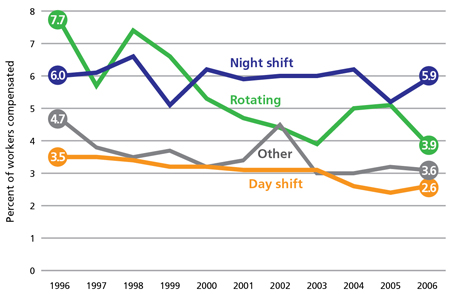Percent of workers compensated for an injury, by shift type, Canada, 1996-2006
In brief
- Shift workers are at increased risk of workplace injury. Sleep disruption and poor quality of sleep are thought to compromise worker attention and lead to injury.
- We used the Survey of Labour and Income Dynamics (SLID) to examine the trend and associations in shift work and workers’ compensation claims in Canada between 1999 and 2005.
- In 1999, there were 2.3 million people working night shift work in Canada, representing 15% of the workforce (9% rotating shift work, 6% regular evening or graveyard). By 2005, there had been an 18% increase in night shiftwork with a 16% increase among men and 22% increase among women.
- Over the same period, compensation rates among day-time workers decreased by 25%, while the decrease among rotating shift workers was about 22%, and there was no decrease among evening or graveyard shift workers.
- Men and women who work night shifts have a higher risk of work injury, compared to those working during the day.
- Women also have a higher risk while in rotating shift work.
- Regulatory agencies and employers need to identify and mitigate factors that give rise to increased work injury among shift workers.
Related publications
Shift work trends and risk for worker injury in Canada
Journal article
Wong I, McLeod CB, Demers P. Scandinavian Journal of Work, Environment & Health. 2011;37(1):54-61.
Media release

